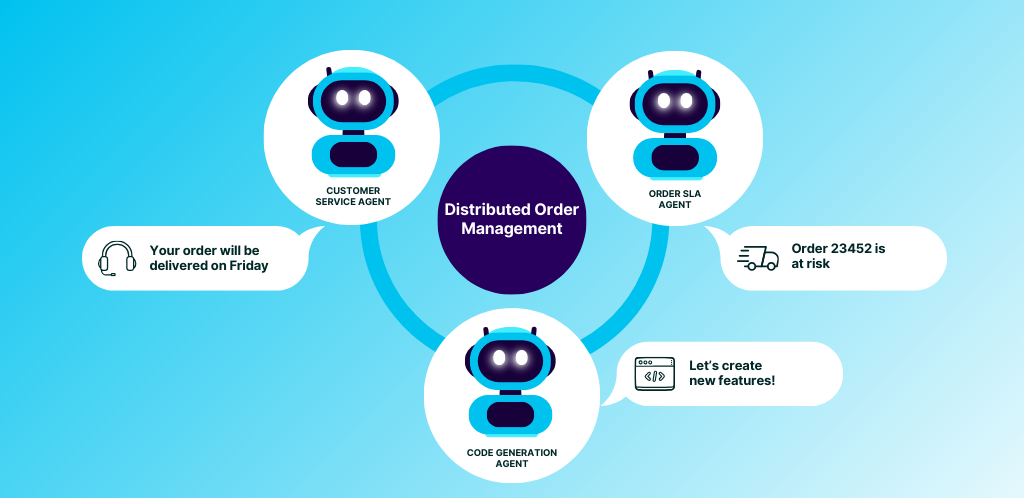As customer expectations soar and supply chains grow more complex, Distributed Order Management (DOM) systems must do more than route orders—they must adapt in real time, resolve issues autonomously, and deliver seamless customer experiences. Enter AI Agents: autonomous, intelligent programs capable of performing domain-specific tasks without constant human input.
Modern DOM platforms like Fluent Order Management, with its composable, API-first architecture and event-driven frameworks, are perfectly positioned to take advantage of this next evolution in operational intelligence.
Here are the top AI Agent use cases that will transform distributed order management:
1. Customer Service AI Agents
AI Agents are redefining the support experience by integrating directly into customer service platforms like Zendesk or Salesforce Service Cloud. But when it comes to use cases involving orders, like handling WISMO (“Where is my order?”) or stock availability (“Can I get it at my local store?”) inquiries, often all the data you need sits within your order management system.
Real-world use cases: Simple ‘inquiry only’
- Order status inquiries – Automatically retrieves real-time order status, shipment tracking, and delivery delay details.
- Stock availability checks – Automatically check if an item is in stock, available locally, or the ‘back in stock date’.
Real world use cases: Complex ‘modify orders’
- Cancel order – Cancels the order if not already being processed for shipment.
- Partial order cancelation – Cancels one or more units of a line item if not already being processed for shipment.
- Change delivery address – Updates delivery address of the order if shipping label has not already been printed.
- Initiate a return – Generates a return merchandise authorization (RMA), and shipping label, if required.
Impact:
- Reduced call handling time and customer wait times
- Reduced call center costs
- Higher CSAT and NPS
2. Order Fulfillment SLA Agents
These agents continuously monitor your fulfilment operations and take action to ensure you meet customer promises.
Key Functions:
- Track orders by SLA, location, carrier, and inventory availability
- Monitor all in-flight orders for anomalies across fulfillment nodes
- Monitor real-time external factors that could impact last-mile logistics, like carrier performance or weather events
- Monitor real-time external factors that could impact inbound inventory and replenishment, such as supplier performance or port delays
- Predict risks using historical data (e.g., store closures, weather, carrier disruptions)
- Flag delayed or stalled orders and recommend alternative fulfillment locations
- Automatically take action to minimize customer impact
Real-world use cases:
- Slow order processing – An AI agent notices a fulfillment node is processing orders slower than usual, putting SLAs at risk. It alerts the central operations team and asks if they would like to reroute orders. Upon verification it automatically reroutes orders to ensure customer promises are kept.
- Carrier delays – An AI agent notices that a carrier is trending late due to a storm near a major city. It re-routes orders through a nearby DC with faster delivery options and updates the customer proactively.
- Supplier delays – An AI agent notices that a supplier has been delivering late, which is impacting replenishment. It reroutes impacted orders, and limits the ability to promise against future inventory for that item to protect the customer experience until the issue has been resolved.
Impact:
- Increase On Time In Full (OTIF) delivery rate
- Higher CSAT and NPS
3. AI Code Generation for Product Extension
AI agents trained on the Fluent Order Management API schema and business logic can enable developers to create code for product extension. This means they can deliver new UI components, rules, and workflows to the business, faster.
Use cases:
- Write JSON code for new UI components, or modify code for existing components
- Generate new fulfillment rules and workflows
- Auto-generate GraphQL queries or validation logic
Impact:
- Reduce implementation effort, and time-to-value
- Reduce time taken to deliver new features to the business (lead time, cycle time, on time delivery, etc.)
- Lower total cost of ownership
- Higher internal team CSAT and NPS
- Increase competitive advantage
AI Agents Are Transforming Order Management
AI agents are changing the game in distributed order management. They’re helping teams work faster, cut costs, and give customers a better experience. Whether it’s answering “Where is my order?” questions, keeping orders on track during carrier delays, or even writing code to update your DOM, these agents are stepping into real business workflows. This means faster response times, fewer manual steps, and a smoother experience for both customers and internal teams. From reducing call center costs to improving on-time delivery rates and speeding up development cycles, AI agents are driving real results. And as order complexity grows, the ability to delegate more of the day-to-day work to intelligent, autonomous agents is becoming a key advantage for retailers who want to move faster and stay ahead.
To learn how Fluent Order Management is enabling AI Agent interactions, contact us today.



